Find Out What Data Is Google Analytics Goals Unable to Track
Find Out What Data Is Google Analytics Goals Unable to Track
Blog Article
Discover the Limitations of Google Analytics Goals: Unveiling the Information Types That Remain Untrackable
As services significantly rely upon data-driven decision-making, understanding the limitations of tools like Google Analytics ends up being paramount. While Google Analytics Goals offer beneficial insights into individual interactions, there exist information kinds that avoid tracking, presenting difficulties to a detailed understanding of customer habits. These untrackable data kinds elevate questions regarding the precision and completeness of the analytics data that companies greatly rely upon for their digital approaches. Interested to discover the hidden blind places in your data analysis procedure?
Incomplete Customer Trip Tracking
Incomplete user journey monitoring within Google Analytics can prevent the ability to precisely examine customer habits. When the user trip is not totally tracked, there are spaces in the information that avoid an extensive understanding of just how customers interact with a website. This lack of insight can cause missed out on possibilities for optimization and improvements to the customer experience.
One common problem with insufficient individual trip tracking is the lack of ability to see the full course that individuals take before finishing a goal or leaving the website. Without this info, it is challenging to determine where users might be encountering barriers or friction factors that stop them from transforming. Additionally, insufficient monitoring can obscure the impact of particular marketing efforts or site modifications on individual actions.
To resolve this restriction, it is critical to establish up appropriate tracking systems within Google Analytics to record the entire individual journey. This might entail setting up occasion monitoring, objective funnels, or utilizing devices like Google Tag Manager to make certain that no important interactions go unrecorded. By obtaining a thorough sight of the customer journey, internet site proprietors can make more educated choices to boost customer interaction and drive conversions.
Attribution Difficulties
Navigating through attribution challenges in Google Analytics needs a comprehensive understanding of how different touchpoints contribute to the general conversion process. Acknowledgment obstacles arise from the complexity of contemporary client trips, where customers interact with numerous networks before transforming.
One typical attribution challenge is the trouble in connecting conversions to the proper resource, especially in situations where individuals connect with multiple networks before converting. In addition, cross-device tracking presents one more attribution difficulty, as users usually change between gadgets during their trip, making it challenging to track their communications perfectly.
Offline Conversions
Given the difficulties related to attributing conversions properly in online channels, the dimension of offline conversions offers a substantial chance for marketing professionals seeking a much more extensive understanding of their consumers' journey. Offline conversions describe actions that customers absorb the physical world, such as making acquisitions in brick-and-mortar stores or over the phone, going to occasions, or engaging with published materials - what data is google analytics goals unable to track. These conversions are crucial for businesses that run both online and offline, as they provide important understandings into the efficiency of advertising and marketing campaigns great site across numerous touchpoints
Tracking offline conversions my latest blog post commonly posed a considerable obstacle for online marketers, as it was testing to attach these activities back to details online interactions precisely. With developments in technology, such as the assimilation of CRM systems, unique identifiers, and discount coupon codes, services can now bridge the space between online and offline information to obtain an extra all natural sight of client actions. By effectively measuring offline conversions, marketing professionals can enhance their strategies, allocate sources a lot more successfully, and inevitably enhance the total consumer experience.
Cross-Device Monitoring
Cross-device tracking plays an essential role in comprehending the interconnected nature of consumers' electronic interactions throughout several tools. In today's omnichannel world, where customers effortlessly switch over in between smart devices, tablets, and desktop computers, tracking their behavior throughout these devices is essential for online marketers to obtain a detailed sight of their customer journey.

Moreover, personal privacy concerns and regulations such as GDPR and CCPA have even more challenging cross-device monitoring. With individuals demanding more control over their data and raised restrictions on monitoring technologies, marketing professionals should discover ingenious and privacy-compliant means to connect user interactions across gadgets.
Dynamic Content Engagement
Recognizing customer interaction with vibrant material is critical in optimizing electronic advertising and marketing approaches for boosted audience interaction. Dynamic web content describes web site components that transform based on user behavior, preferences, or other variables, supplying a tailored experience. Tracking user interactions with vibrant material positions difficulties for standard analytics tools like Google Analytics.
While Google Analytics can track standard interactions like clicks and web page sights, it might battle to record more nuanced involvements within dynamic content. what data is google analytics goals unable to track. Metrics such as time invested on certain dynamic components, hover activities, or interactions within pop-ups are frequently not conveniently quantifiable making use of standard monitoring methods. This constraint prevents marketing experts' capability to totally grasp just how users are involving with vibrant web see this website content and tailor their strategies appropriately

Final Thought
To conclude, Google Analytics goals have restrictions in tracking insufficient customer journeys, associating conversions precisely, recording offline conversions, tracking cross-device interactions, and determining vibrant material engagement. These constraints highlight the relevance of exploring additional tracking techniques and devices to obtain an extra thorough understanding of user habits and conversions past what Google Analytics can supply.
While Google Analytics Goals deal beneficial insights into user interactions, there exist data types that avoid tracking, positioning obstacles to an extensive understanding of individual behavior.Incomplete user journey tracking within Google Analytics can hinder the capacity to properly analyze user actions. When the individual journey is not completely tracked, there are gaps in the data that stop a thorough understanding of how users interact with a site.One typical issue with insufficient customer trip monitoring is the lack of ability to see the full path that users take before finishing a goal or leaving the website. By obtaining a comprehensive sight of the individual trip, site owners can make even more educated decisions to boost user interaction and drive conversions.
Report this page